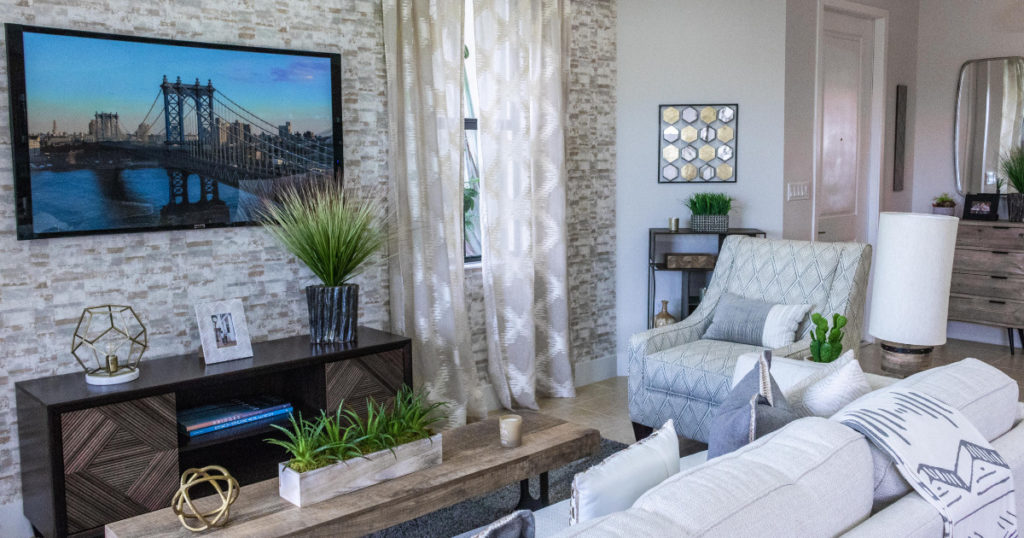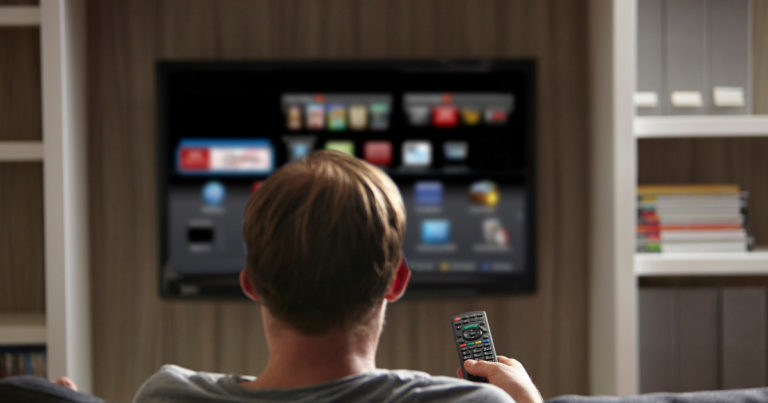Contents
- Introduction: TV Sizes
- Understanding TV Sizes
- Factors to Consider When Choosing a TV Size
- Popular TV Sizes and Their Features
- Determining the Right TV Size for Your Space
- Adjusting TV Size Based on Resolution and Aspect Ratio
- Considering Additional Factors for Selecting TV Sizes
- Tips for Testing and Assessing TV Sizes
With the ever-expanding range of TV sizes available, it can be overwhelming to determine the perfect fit for your living room, bedroom, or entertainment area. Fear not, as we dig into the world of TV sizes, providing insights, tips, and recommendations to help you make an informed decision.
From compact screens for cozy spaces to larger-than-life displays for a cinematic experience, we shall unravel the intricacies of TV sizes and help you find the ideal one to transform your viewing sessions into unforgettable moments of entertainment.
Get ready to discover the perfect TV size that will enhance your visual experience and bring your favorite shows, movies, and games to life. Whether you’re in the market for a new television or simply curious about the optimal screen size for your viewing pleasure, this blog post has got you covered.
Introduction: TV Sizes
Selecting the right TV size is paramount in creating an immersive and enjoyable viewing experience. Whether you’re upgrading your current television or embarking on a new purchase, understanding TV sizes and making an informed choice can greatly impact your viewing pleasure. That’s where our comprehensive guide comes in.
The purpose of this ultimate guide is to empower you with the knowledge and insights needed to choose the perfect screen size for your specific viewing needs. We’ll delve into the intricacies of TV sizes, discussing the factors you should consider, and providing practical tips to help you make the best decision. From small and compact TVs ideal for cozy spaces to larger screens that create a cinematic atmosphere, we’ll cover it all.
By the end of this guide, you’ll have a solid understanding of how TV sizes are measured, the relationship between screen size and viewing distance, and how to assess the perfect TV size for your living room, bedroom, or entertainment area. Get ready to elevate your viewing pleasure as we embark on a journey to find the ideal TV size that will bring your favorite movies, shows, and games to life. Let’s dive in!
Understanding TV Sizes
When it comes to understanding TV sizes, it’s essential to grasp how they are measured and the different units used for measurement.
This section will provide you with the knowledge you need to navigate TV sizes effectively while clearing up common misconceptions along the way.
Explanation of how TV Sizes are measured
TV sizes are measured diagonally from one corner of the screen to the opposite corner.
The measurement represents the length of the diagonal line across the screen, typically in inches or centimeters. For example, a 55-inch TV means the screen measures 55 inches diagonally from corner to corner.
Different TV Sizes measurement units (inches, centimeters)
TV sizes are commonly expressed in both inches and centimeters.
While inches are more prevalent in countries like the United States, centimeters are widely used in many other parts of the world. Understanding both units allows you to compare TV sizes across different regions and manufacturers.
| TV Size (inches) | Length (cm) | Width (cm) | Diagonal (cm) |
|---|---|---|---|
| 15 | 33.3 | 18.8 | 38.1 |
| 19 | 41.9 | 23.6 | 48.3 |
| 22 | 48.8 | 27.4 | 55.9 |
| 24 | 53.1 | 29.7 | 61 |
| 28 | 62.2 | 35.1 | 71.1 |
| 32 | 70.9 | 40 | 81.3 |
| 36 | 80 | 45 | 91.4 |
| 40 | 89.9 | 50.5 | 101.6 |
| 43 | 96 | 54 | 109.2 |
| 49 | 109.2 | 61.7 | 124.5 |
| 50 | 110.7 | 62.2 | 127 |
| 55 | 121.7 | 68.3 | 139.7 |
| 60 | 132.8 | 74.7 | 152.4 |
| 65 | 143.9 | 81 | 165.1 |
| 70 | 154.9 | 87.4 | 177.8 |
| 75 | 166.1 | 93.4 | 190.5 |
| 80 | 177.3 | 99.6 | 203.2 |
| 85 | 188.5 | 105.8 | 215.9 |
| 90 | 199.7 | 112 | 228.6 |
| 100 | 221.2 | 124.7 | 254 |
| 120 | 266 | 149.6 | 304.8 |
Clearing up common misconceptions about TV sizes
There are a few misconceptions surrounding TV sizes that are worth dispelling. Firstly, the size mentioned for a TV refers to the screen size and not the overall dimensions, including the bezel or frame.
Additionally, some people assume that a larger TV will always provide a better viewing experience. However, factors like viewing distance, room size, and resolution also play significant roles in determining the optimal TV size for your setup.
By grasping the measurement methodology, familiarizing yourself with both inches and centimeters, and understanding the misconceptions surrounding TV sizes, you’ll be better equipped to make informed decisions when it comes to choosing the perfect TV size for your needs.
Let’s proceed to the next section and explore the factors you should consider in selecting an ideal TV size.
Factors to Consider When Choosing a TV Size
Selecting the right TV size involves considering various factors that contribute to an optimal viewing experience. In this section, we will explore three key factors to help you make an informed decision.
Viewing distance and optimal screen size relationship
The viewing distance, or the distance between you and the TV, plays a crucial role in determining the ideal screen size.
As a general rule, the screen size should be proportionate to the viewing distance. A larger screen may be suitable for a spacious living room, while a smaller screen may be more appropriate for a bedroom or office.
Understanding the relationship between viewing distance and screen size ensures that you can comfortably see all the details without straining your eyes.
Impact of room size and layout on TV size selection
Consider the size and layout of the room where the TV will be placed.
A large TV in a small room may overwhelm the space, while a small TV in a large room may appear underwhelming.
Take into account the available wall or entertainment unit space to ensure the TV fits well and complements the overall aesthetics of the room.
Considering the viewing angle for optimal comfort
The viewing angle refers to the angle at which you sit in relation to the TV screen.
It’s important to consider the seating arrangement and ensure that everyone has a comfortable viewing angle. If the viewing angle is too wide or too narrow, it can result in distorted images or reduced clarity.
Optimal viewing angles typically range from 30 to 40 degrees off-center from the screen.
By taking into account the viewing distance, room size and layout, as well as the viewing angle, you can select a TV size that offers an immersive and enjoyable viewing experience. In the next section, we will explore popular TV sizes and their features to help you narrow down your options.
Popular TV Sizes and Their Features
Small to Medium Sizes (32-55 inches)
When it comes to small to medium-sized TVs, ranging from 32 to 55 inches, there are several benefits and considerations to keep in mind. These sizes are well-suited for bedrooms, offices, and smaller living rooms.
Benefits and considerations of compact TVs
- Space efficiency: Compact TVs are perfect for rooms with limited space, as they offer a balance between screen size and physical footprint.
- Versatility: These TVs are versatile and can be easily mounted on a wall or placed on a smaller entertainment unit.
- Cost-effective: Smaller-sized TVs generally come at more affordable price points, making them a budget-friendly option.
Recommended TV sizes for bedrooms, offices, and smaller living rooms
- 32 to 43 inches: These sizes are ideal for bedrooms, kitchens, or home offices, where the viewing distance is typically shorter.
- 48 to 55 inches: A step up in size, these TVs can be suitable for smaller living rooms or areas where you want a slightly more immersive viewing experience.
Large Sizes (60-85 inches)
Large-sized TVs offer a whole new level of immersion and are perfect for spacious living rooms, home theaters, and gaming setups. Here are some advantages of larger screens
Advantages of larger screens for immersive experiences
- Enhanced viewing experience: Larger screens provide a more cinematic feel, making movies, sports events, and gaming more engaging.
- Detail and clarity: With more screen real estate, you can appreciate the intricate details and finer nuances of high-definition content.
- Impressive presence: A large TV becomes a focal point in the room, adding a touch of elegance and grandeur to your entertainment setup.
Optimal TV sizes for spacious living rooms, home theaters, and gaming setups
- 60 to 75 inches: These sizes strike a balance between size and practicality, offering a captivating viewing experience for larger living rooms or dedicated home theater spaces.
- 80 to 85 inches: For those who crave a truly immersive experience, these larger sizes create a theater-like atmosphere and are ideal for spacious areas.
Consider your viewing preferences, room size, and intended use when selecting between small to medium-sized TVs or larger screens. The next section will guide you in determining the right TV size for your specific space and needs.
Determining the Right TV Size for Your Space

Choosing the perfect TV size for your specific space involves careful consideration and measurement.
In this section, we will provide you with a step-by-step guide to measure your viewing area and calculate the ideal TV size. We will also introduce interactive tools and online resources to assist you in the TV size selection process.
Step-by-step guide to measure your viewing area and calculate ideal TV size
- Measure the available space: Begin by measuring the width and height of the area where the TV will be placed. Consider any constraints such as walls, furniture, or cabinets that may affect the maximum size the TV can be.
- Determine the optimal viewing distance: The ideal viewing distance is typically around 1.5 to 2.5 times the diagonal screen size. Multiply the screen size by a factor within this range to determine the recommended viewing distance. For example, if you have a 55-inch TV, multiply it by 1.5 and 2.5 to get a range of 82.5 inches (2.09 meters) to 137.5 inches (3.49 meters).
- Consider the room layout and seating arrangement: Take into account the seating arrangement and ensure that everyone has a comfortable viewing angle. Adjust the TV size if necessary to accommodate multiple viewing positions or if the seating area is not directly facing the TV.
Table of TV sizes and distance from the screen
| TV Size (inches) | Recommended Viewing Distance (feet) | Recommended Viewing Distance (meters) |
|---|---|---|
| 32 | 4 - 6 | 1.2 - 1.8 |
| 40 | 5 - 8 | 1.5 - 2.4 |
| 50 | 6 - 10 | 1.8 - 3.0 |
| 55 | 7 - 11 | 2.1 - 3.4 |
| 60 | 8 - 12 | 2.4 - 3.7 |
| 65 | 8.5 - 13.5 | 2.6 - 4.1 |
| 70 | 9 - 14 | 2.7 - 4.3 |
| 75 | 10 - 15 | 3.0 - 4.6 |
| 80 | 10.5 - 16.5 | 3.2 - 5.0 |
| 85 | 11 - 17 | 3.4 - 5.2 |
| 90 | 11.5 - 18 | 3.5 - 5.5 |
| 100 | 13 - 20 | 4.0 - 6.1 |
Interactive tools and online resources for TV size selection
- Online TV size calculators: Numerous websites offer TV size calculators where you input your viewing distance or room dimensions, and they provide recommended TV sizes based on industry standards and viewing preferences.
- Virtual room planners: Some furniture or electronics retailers provide virtual room planners that allow you to visualize different TV sizes within your space. These tools can give you a better understanding of how a specific TV size will fit and look in your room.
- Manufacturer websites: TV manufacturer websites often provide detailed specifications, including dimensions, for each model they offer. Use these specifications to compare the dimensions of different TVs and find the one that suits your space.
By following the step-by-step measurement guide and utilizing interactive tools and online resources, you can determine the right TV size that fits perfectly in your space and delivers an optimal viewing experience. In the next section, we will explore additional factors to consider when adjusting TV size based on resolution and aspect ratio.
Adjusting TV Size Based on Resolution and Aspect Ratio
When selecting a TV size, it’s essential to consider not only the physical dimensions but also the screen resolution and aspect ratio. In this section, we will explore how screen resolution and aspect ratio impact the optimal viewing experience.
Impact of screen resolution on optimal viewing distance
Different screen resolutions, such as HD (720p), Full HD (1080p), and 4K Ultra HD (2160p), offer varying levels of detail and clarity.
Higher resolution displays can showcase more intricate details, but they may require you to sit closer to fully appreciate the benefits.
Here are some general guidelines for optimal viewing distances:
- HD (720p): Suitable for smaller screen sizes (32-43 inches) and optimal viewing distance ranges from 4 to 6.5 feet (1.2-2 meters).
- Full HD (1080p): Ideal for medium-sized screens (48-55 inches) with optimal viewing distance ranging from 6 to 9 feet (1.8-2.7 meters).
- 4K Ultra HD (2160p): Recommended for larger screens (60 inches and above), and optimal viewing distance is typically 8 feet (2.4 meters) or more.
Adjusting the TV size based on the screen resolution ensures you can fully appreciate the level of detail without compromising the viewing experience.
Understanding aspect ratios and their effects on content display
Aspect ratio refers to the proportion of width to height of the TV screen.
The two most common aspect ratios are 16:9 (widescreen) and 4:3 (traditional). Here are some key points to consider:
- 16:9 aspect ratio: This is the standard widescreen format used for most modern TVs. It is well-suited for movies, TV shows, and gaming, providing a more immersive viewing experience.
- 4:3 aspect ratio: This format is more commonly found in older TVs and is ideal for displaying traditional content, such as older TV shows or certain video games.
When selecting a TV size, consider the aspect ratio of the content you most frequently watch to ensure optimal display without any stretching or distortion.
By understanding the impact of screen resolution on viewing distance and the importance of aspect ratios for content display, you can adjust the TV size to match the resolution and aspect ratio requirements of your preferred content. In the next section, we will discuss additional factors to consider when choosing a TV size, including mounting options and audio considerations.
Considering Additional Factors for Selecting TV Sizes
Choosing the right TV size involves considering additional factors that contribute to a well-rounded home theater setup. In this section, we will discuss two important considerations: mounting options and audio considerations.
Mounting options and their impact on TV placement and size selection

Mounting your TV can provide flexibility in terms of placement and can also affect the perceived size of the TV. Consider the following options:
- Wall mounting: Mounting the TV on a wall can save space and create a sleek, minimalist look. It also allows for better viewing angles and can make the TV appear larger than it would on a stand.
- Stand placement: Placing the TV on a stand or entertainment unit offers stability and convenience. It’s important to ensure that the stand can accommodate the size and weight of the TV.
When selecting a TV size, take into account the available mounting options and consider how they may impact the overall aesthetics and functionality of your viewing area.
Audio considerations for a balanced home theater setup
While the TV itself provides visuals, audio plays a crucial role in creating an immersive home theater experience. Here are some audio considerations:
- Soundbar or speaker system: Consider complementing your TV with a soundbar or a separate speaker system. These audio devices enhance the sound quality, providing a more immersive and balanced audio experience.
- Room acoustics: Take into account the size and layout of the room, as well as any acoustic challenges that may affect the audio quality. Consider adding sound-absorbing materials or adjusting the speaker placement for optimal sound dispersion.
When planning your TV setup, ensure that the audio complements the visual experience, creating a well-balanced and immersive home theater environment.
By considering mounting options and audio considerations, you can enhance the overall viewing experience and create a well-rounded home theater setup.
In the final section, we will recap the key points discussed in this guide and provide a summary of the steps to choose the perfect TV size.
Tips for Testing and Assessing TV Sizes
When it comes to choosing the perfect TV size, there’s no substitute for firsthand experience and expert advice. In this section, we will provide you with tips on testing and assessing TV sizes to ensure you make an informed decision.
Visiting showrooms and experiencing different screen sizes in person
Take the opportunity to visit electronics showrooms or retailers that have a wide range of TVs on display. This allows you to see different screen sizes firsthand and assess their visual impact.
Spend some time viewing content on various TVs to get a sense of the size that feels most comfortable and immersive to you. This firsthand experience will help you make a more informed decision when selecting the right TV size for your home.
Seeking expert advice and consulting trusted sources
If you’re uncertain about which TV size to choose, it can be helpful to seek expert advice.
Consult with knowledgeable sales representatives in electronics stores or home theater specialists who can provide insights and recommendations based on your specific requirements.
Additionally, consider trusted sources such as reputable technology websites or consumer reviews to gather information and insights from other users’ experiences.
Remember, everyone’s preferences and viewing environments are unique, so it’s important to test and assess TV sizes based on your personal preferences and the characteristics of your space.
In conclusion, understanding how TV sizes are measured, considering factors such as viewing distance and room layout, and taking into account screen resolution and aspect ratios will help you choose the ideal TV size. By visiting showrooms, experiencing different sizes in person, seeking expert advice, and consulting trusted sources, you can make a well-informed decision that ensures an optimal viewing experience in your home.
Now that you have all the information and tips necessary to choose the perfect TV size, it’s time to embark on your journey of finding the ideal TV that will enhance your viewing pleasure.



